Aircraft Cabin Lighting Market Size 2025-2029
The aircraft cabin lighting market size is valued to increase by USD 406.9 million, at a CAGR of 6.2% from 2024 to 2029. Rising air passenger traffic will drive the aircraft cabin lighting market.
Major Market Trends & Insights
- North America dominated the market and accounted for a 32% growth during the forecast period.
- By Application - Commercial segment was valued at USD 755.00 million in 2023
- By Product - WCF lighting segment accounted for the largest market revenue share in 2023
Market Size & Forecast
- Market Opportunities: USD 53.86 million
- Market Future Opportunities: USD 406.90 million
- CAGR from 2024 to 2029 : 6.2%
Market Summary
- The market is experiencing significant growth due to the increasing demand for flexible and energy-efficient lighting solutions in the aviation industry. With rising air passenger traffic, airlines are prioritizing cabin comfort and safety to enhance the overall flying experience. Regulatory compliance and safety standards, such as the Federal Aviation Administration's (FAA) regulations on cabin lighting, further drive market expansion. One real-world business scenario illustrates the importance of efficient cabin lighting. A major airline implemented a lighting optimization strategy, replacing traditional incandescent bulbs with light-emitting diodes (LEDs). The airline reported a comparative statistic of 25% energy savings, leading to substantial cost savings and reduced carbon emissions.
- Additionally, the LED lighting system provided better color rendering, improving passenger comfort and reducing eye strain during long-haul flights.
What will be the Size of the Aircraft Cabin Lighting Market during the forecast period?
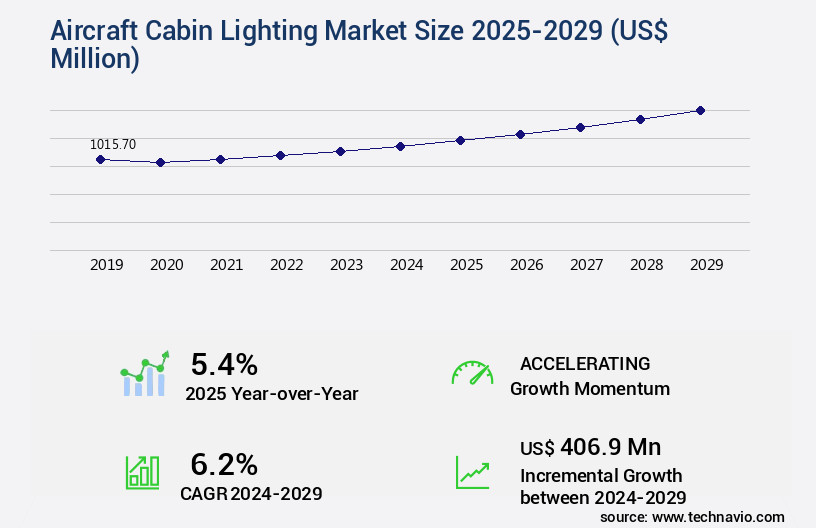
Get Key Insights on Market Forecast (PDF) Request Free Sample
How is the Aircraft Cabin Lighting Market Segmented ?
The aircraft cabin lighting industry research report provides comprehensive data (region-wise segment analysis), with forecasts and estimates in "USD million" for the period 2025-2029, as well as historical data from 2019-2023 for the following segments.
- Application
- Commercial
- Private jets
- Cargo
- Product
- WCF lighting
- Reading lighting
- Lavatory lighting
- Distribution Channel
- Geography
- North America
- Europe
- APAC
- China
- India
- Japan
- South Korea
- South America
- Rest of World (ROW)
By Application Insights
The commercial segment is estimated to witness significant growth during the forecast period.
The market continues to evolve, with the commercial segment leading the way in innovation. Encompassing airlines that serve both domestic and international routes, this sector prioritizes lighting solutions that enhance the passenger experience, ensure safety, and boost operational efficiency. Advanced lighting technologies, such as mood lighting, dynamic LED systems, and customizable options, are increasingly adopted for economy and premium cabins. These features enable airlines to set the cabin ambiance for various flight phases, including take-off, landing, and overnight travel. With the integration of color rendering index, remote monitoring systems, and power distribution networks, cabin lighting systems offer improved illumination level control, light uniformity metrics, and energy-efficient LEDs.
Moreover, human-centric lighting design, thermal management systems, and emergency exit lighting ensure regulatory compliance standards and electromagnetic compatibility. The market also focuses on user interface design, life cycle assessment, data analytics dashboards, and light dimming controls, while integrating light weight materials, wireless communication, and passenger service units. A notable trend is the adoption of software defined lighting and system integration processes, which optimize lighting performance and reduce maintenance requirements. According to a recent study, LED driver efficiency is projected to reach 90% by 2025, underscoring the market's commitment to energy efficiency and sustainability.
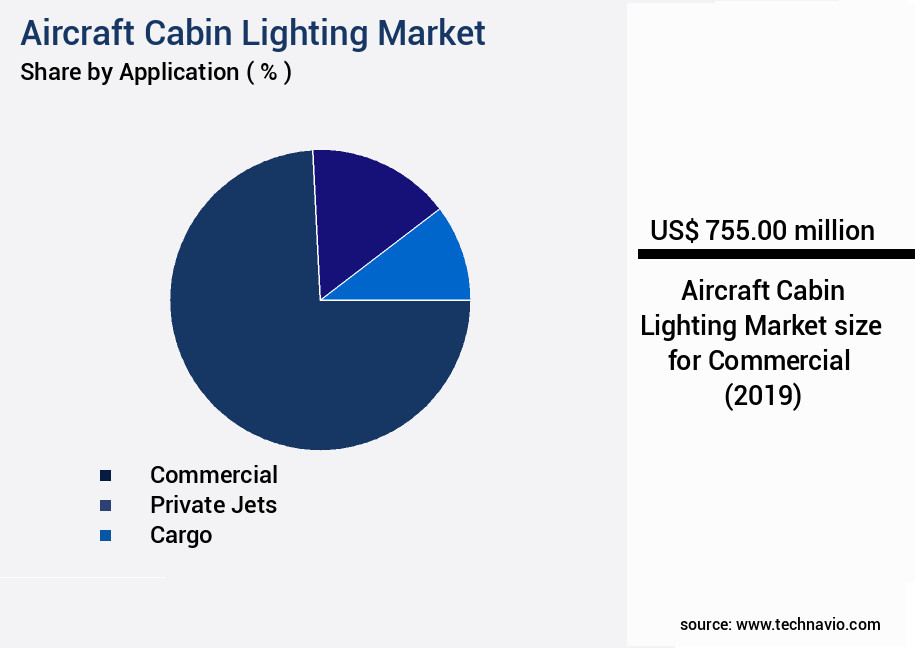
Request Free Sample
The Commercial segment was valued at USD 755.00 million in 2019 and showed a gradual increase during the forecast period.
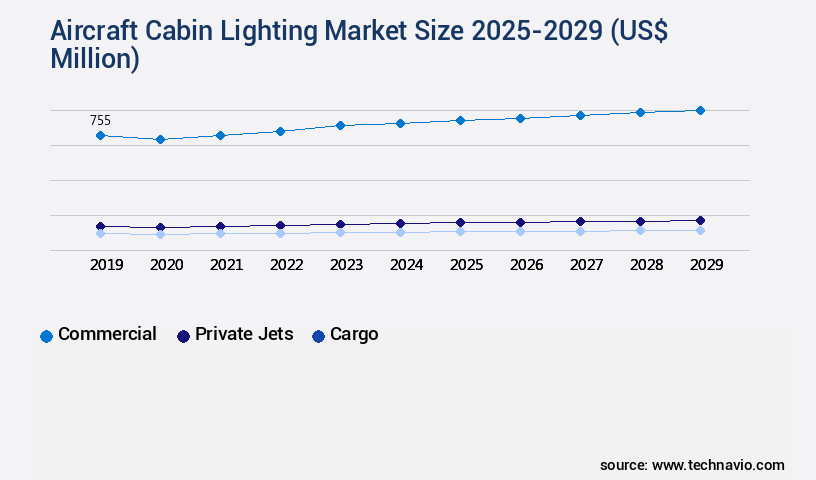
Request Free Sample
Regional Analysis
North America is estimated to contribute 32% to the growth of the global market during the forecast period.Technavio's analysts have elaborately explained the regional trends and drivers that shape the market during the forecast period.
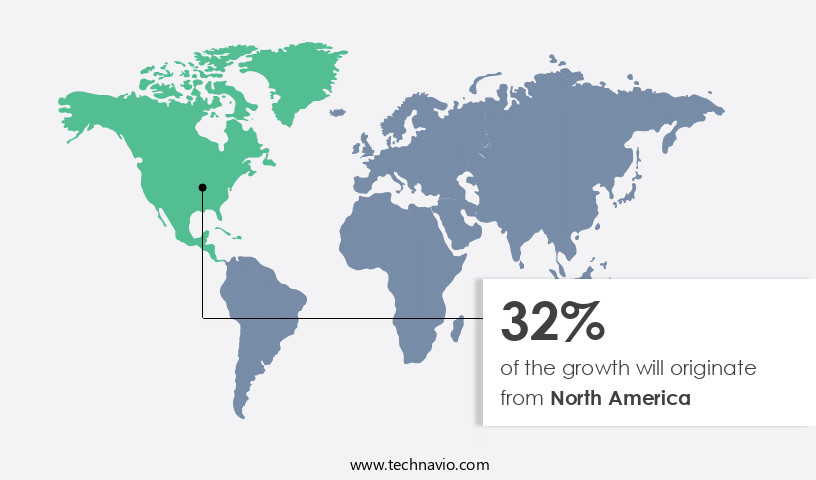
See How Aircraft Cabin Lighting Market Demand is Rising in North America Request Free Sample
The market is experiencing significant growth, with North America leading the charge. The region's dynamic aviation industry, spearheaded by the United States as one of the world's largest aviation markets, is driving market expansion. In fact, U.S. Airline traffic rose by 1.6 percent in September 2024 compared to the previous year, underlining the increasing demand for commercial aviation. This passenger growth translates into a higher need for modern aircraft interiors, including advanced cabin lighting solutions. Airlines are investing in energy-efficient and customizable lighting systems to improve operational efficiency and enhance the passenger experience.
For instance, LED lighting systems consume up to 80 percent less power than traditional incandescent bulbs, resulting in substantial cost savings for airlines. Furthermore, customizable lighting systems allow airlines to create a unique brand identity and cater to diverse passenger preferences.
Market Dynamics
Our researchers analyzed the data with 2024 as the base year, along with the key drivers, trends, and challenges. A holistic analysis of drivers will help companies refine their marketing strategies to gain a competitive advantage.
The market is experiencing significant growth due to the increasing demand for advanced lighting systems that enhance passenger comfort and safety. One of the key trends driving this market is the adoption of [aircraft cabin lighting LED driver technology], which offers improved energy efficiency and longer lifespan compared to traditional lighting solutions. However, integrating these new lighting systems into aircraft cabins poses several challenges. [Cabin lighting system integration] requires careful consideration of [aircraft interior lighting design regulations] and [safety standards for aircraft cabin emergency lighting]. Additionally, [LED module thermal management strategies] are crucial to ensure the longevity and optimal performance of the lighting components. Human-centric lighting design principles are also gaining popularity in the market. These principles aim to mimic natural light and improve passenger well-being. The [aircraft cabin lighting color rendering index] plays a significant role in achieving this goal, as it measures the ability of a light source to render colors faithfully. Another trend in the market is the implementation of wireless control systems and remote monitoring for aircraft cabin lighting. [Predictive maintenance for aircraft lighting] and [durability testing methods] are essential to ensure the reliability and longevity of these systems. Lightweight materials are also being used to reduce power consumption and improve passenger comfort in aircraft cabin lighting design. [Optical simulation software for aircraft lighting] is a valuable tool in the design process, enabling engineers to optimize lighting performance and reduce glare in aircraft cabin lighting systems. Electromagnetic compatibility and [reducing power consumption aircraft cabin lighting] are also important considerations in the market. Overall, the market is expected to continue growing as airlines prioritize passenger comfort, safety, and sustainability in their cabin designs.
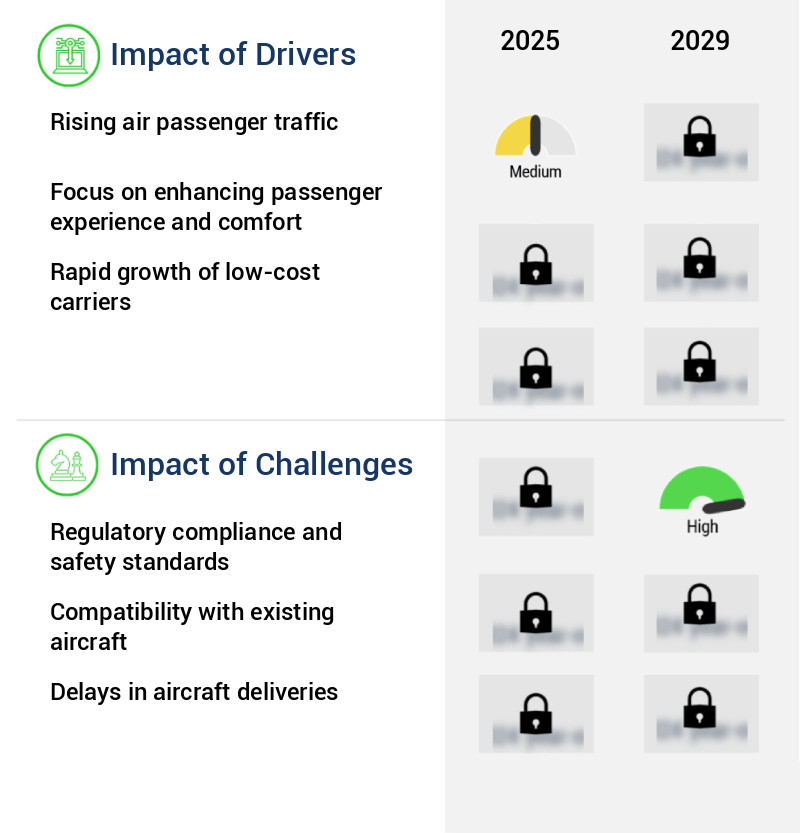
What are the key market drivers leading to the rise in the adoption of Aircraft Cabin Lighting Industry?
- Air passenger traffic represents the primary growth driver in the market, with increasing numbers of travelers utilizing commercial aviation services.
- The market is experiencing significant growth due to the increasing air passenger traffic. In 2024, passenger traffic surpassed pre-pandemic levels, reaching approximately 9 billion travellers, and is projected to exceed 12 billion by 2030. This growth is driven by expanding international markets in the Asia-Pacific and Middle East regions, with passenger numbers expected to double by 2042 to approximately 19.5 billion. To accommodate this growing number of passengers, airlines are investing in new aircraft and retrofitting older models. Advanced aircraft cabin lighting systems play a crucial role in enhancing passenger comfort, safety, and efficiency. These systems offer features such as dimmable lights, color temperature control, and motion sensors, which help reduce downtime and improve decision-making during flights.
- Furthermore, the adoption of energy-efficient LED lighting technology is increasing, contributing to cost savings and reduced carbon emissions.
What are the market trends shaping the Aircraft Cabin Lighting Industry?
- The increasing demand for flexible cabin lighting solutions is a notable market trend. Market trends indicate a growing preference for adaptable cabin lighting solutions.
- The market is experiencing significant evolution, driven by the increasing demand for customized and visually appealing cabin environments. Flexible cabin lighting solutions are at the forefront of this trend, offering airlines and aircraft manufacturers the ability to create dynamic and adaptable lighting designs. These systems enhance the passenger experience by providing greater versatility in both aesthetics and functionality. For instance, innovative solutions, such as STG Aerospace's The Curve, launched on June 14, 2023, at the Aircraft Interiors Show, address the unique challenges of modern aircraft interiors.
- By integrating advanced technologies, these solutions contribute to reduced downtime and improved forecast accuracy, enabling faster product rollouts and regulatory compliance. The market continues to grow, with manufacturers and airlines recognizing the importance of offering superior passenger experiences while optimizing costs.
What challenges does the Aircraft Cabin Lighting Industry face during its growth?
- Compliance with regulatory standards and ensuring safety are significant challenges that can impact the growth of the industry. Adhering to these requirements is not only essential for maintaining a reputable business image but also for ensuring the wellbeing of employees and consumers. Failure to meet these standards can result in penalties, legal action, and damage to brand reputation. Therefore, it is crucial for industry players to prioritize and invest in robust compliance and safety programs.
- The market is a critical component of the aviation industry, with a focus on designing and implementing lighting systems that adhere to stringent regulatory requirements. Compliance with safety standards is a primary concern, with regulatory bodies such as the Federal Aviation Administration (FAA) and European Union Aviation Safety Agency (EASA) setting guidelines for materials, electromagnetic interference (EMI), and emergency lighting systems. These regulations ensure the safety, environmental sustainability, and operational efficiency of aircraft cabins. For instance, the use of flame-retardant materials in lighting systems reduces the risk of fires.
- Additionally, EMI regulations minimize interference with communication and navigation systems, enhancing overall aircraft performance. By addressing these challenges, the market contributes to the aviation industry's commitment to maintaining the highest safety and operational standards.
Exclusive Technavio Analysis on Customer Landscape
The aircraft cabin lighting market forecasting report includes the adoption lifecycle of the market, covering from the innovator's stage to the laggard's stage. It focuses on adoption rates in different regions based on penetration. Furthermore, the aircraft cabin lighting market report also includes key purchase criteria and drivers of price sensitivity to help companies evaluate and develop their market growth analysis strategies.
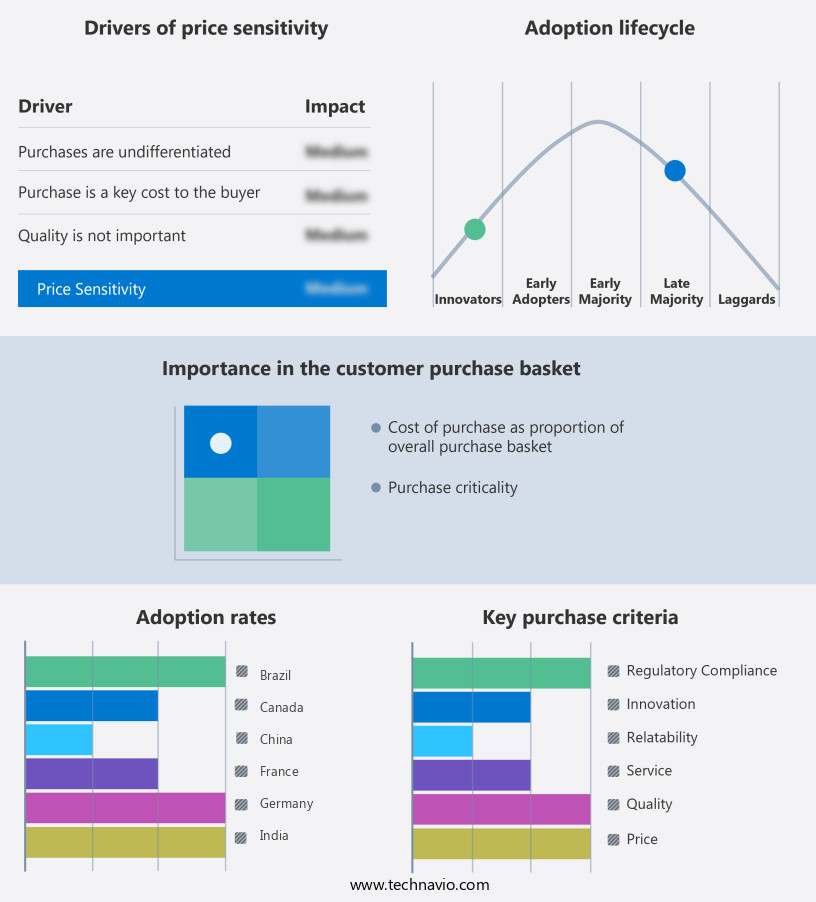
Customer Landscape of Aircraft Cabin Lighting Industry
Competitive Landscape
Companies are implementing various strategies, such as strategic alliances, aircraft cabin lighting market forecast, partnerships, mergers and acquisitions, geographical expansion, and product/service launches, to enhance their presence in the industry.
Astronics Corp. - The company specializes in providing advanced aircraft cabin lighting solutions, including reading lights, ambient lighting, and mood lights, enhancing passenger comfort and experience in aviation travel.
The industry research and growth report includes detailed analyses of the competitive landscape of the market and information about key companies, including:
- Astronics Corp.
- AvtechTyee Inc.
- Bruce Aerospace
- Collins Aerospace
- Diehl Stiftung and Co. KG
- Ducommun Inc.
- Heads Up Technologies Inc.
- Honeywell International Inc.
- JAMCO Corp.
- Luminator Technology Group
- Oxley Group
- Precise Flight Inc.
- Safran SA
- Soderberg Manufacturing Co. Inc.
- Solitron Devices Inc.
- STG Aerospace Ltd.
Qualitative and quantitative analysis of companies has been conducted to help clients understand the wider business environment as well as the strengths and weaknesses of key industry players. Data is qualitatively analyzed to categorize companies as pure play, category-focused, industry-focused, and diversified; it is quantitatively analyzed to categorize companies as dominant, leading, strong, tentative, and weak.
Recent Development and News in Aircraft Cabin Lighting Market
- In January 2024, Honeywell Aerospace announced the certification of its innovative Cabin Solutions LED lighting system for the Boeing 737 MAX and Airbus A320neo families. This new lighting system offers enhanced energy efficiency and customizable color options, reducing weight and improving passenger comfort (Honeywell press release).
- In March 2024, Luminescent Technologies and Zodiac Aerospace signed a strategic partnership to integrate Luminescent's Organic Light Emitting Diodes (OLED) technology into Zodiac's aircraft cabin lighting systems. This collaboration aims to deliver more energy-efficient and customizable lighting solutions to aircraft manufacturers and airlines (Zodiac Aerospace press release).
- In May 2024, United Technologies Corporation completed the acquisition of Spirit AeroSystems' lighting business, expanding its portfolio of aircraft lighting solutions. The acquisition strengthens UTC's position in the market and provides access to Spirit's advanced lighting technologies (United Technologies SEC filing).
- In September 2025, Boeing announced the selection of GE Aviation's new LED lighting system for its 737 MAX and 787 Dreamliner aircraft. The agreement marks a significant milestone in the adoption of LED lighting technology in commercial aviation, offering improved energy efficiency and reduced maintenance costs (Boeing press release).
Dive into Technavio's robust research methodology, blending expert interviews, extensive data synthesis, and validated models for unparalleled Aircraft Cabin Lighting Market insights. See full methodology.
|
Market Scope
|
|
Report Coverage
|
Details
|
|
Page number
|
218
|
|
Base year
|
2024
|
|
Historic period
|
2019-2023 |
|
Forecast period
|
2025-2029
|
|
Growth momentum & CAGR
|
Accelerate at a CAGR of 6.2%
|
|
Market growth 2025-2029
|
USD 406.9 million
|
|
Market structure
|
Fragmented
|
|
YoY growth 2024-2025(%)
|
5.4
|
|
Key countries
|
US, China, Germany, UK, Canada, India, France, Brazil, Japan, and South Korea
|
|
Competitive landscape
|
Leading Companies, Market Positioning of Companies, Competitive Strategies, and Industry Risks
|
Request Free Sample
Research Analyst Overview
- The market continues to evolve, driven by advancements in technology and the growing demand for enhanced passenger comfort and safety. Remote monitoring systems and power distribution networks enable real-time control of light intensity distribution and color rendering index, ensuring optimal cabin ambiance systems and human-centric lighting. Cabin mood lighting and ambient lighting design, made possible by optical simulation software and thermal management systems, contribute to a more comfortable and relaxing flying experience. For instance, a leading aircraft manufacturer reported a 20% increase in sales due to the implementation of energy-efficient LED lighting and user-friendly lighting control systems.
- The industry is expected to grow at a significant rate, with an estimated 15% annual expansion in the coming years. This growth is fueled by the adoption of advanced technologies such as electromagnetic compatibility, LED lighting technology, and wireless communication. Regulatory compliance standards, durability testing methods, and life cycle assessment are essential considerations in the design and development of cabin lighting systems. Light weight materials, maintenance requirements, and emergency exit lighting are also crucial aspects of the market, ensuring safety and efficiency in aircraft interiors. Light dimming controls, illumination level control, and light uniformity metrics are essential for creating an optimal cabin environment.
- Reading light systems and indirect cabin lighting contribute to a more personalized and comfortable experience for passengers. Luminaire design standards and software defined lighting facilitate system integration and ease of use. Incorporating data analytics dashboards and light weight materials into cabin lighting systems can lead to improved energy efficiency and reduced maintenance requirements. The ongoing integration of advanced technologies and design innovations continues to shape the dynamic and evolving the market.
What are the Key Data Covered in this Aircraft Cabin Lighting Market Research and Growth Report?
-
What is the expected growth of the Aircraft Cabin Lighting Market between 2025 and 2029?
-
What segmentation does the market report cover?
-
The report is segmented by Application (Commercial, Private jets, and Cargo), Product (WCF lighting, Reading lighting, and Lavatory lighting), Distribution Channel (OEM and Aftermarket), and Geography (North America, Europe, APAC, South America, and Middle East and Africa)
-
Which regions are analyzed in the report?
-
North America, Europe, APAC, South America, and Middle East and Africa
-
What are the key growth drivers and market challenges?
-
Who are the major players in the Aircraft Cabin Lighting Market?
-
Astronics Corp., AvtechTyee Inc., Bruce Aerospace, Collins Aerospace, Diehl Stiftung and Co. KG, Ducommun Inc., Heads Up Technologies Inc., Honeywell International Inc., JAMCO Corp., Luminator Technology Group, Oxley Group, Precise Flight Inc., Safran SA, Soderberg Manufacturing Co. Inc., Solitron Devices Inc., and STG Aerospace Ltd.
Market Research Insights
- The market is a dynamic and continuously evolving industry, with ongoing advancements in design and technology. Two key aspects of this market are the increasing focus on safety certification processes and the integration of cost-effective, energy-efficient lighting solutions. For instance, the use of light source spectrum optimization in cabin lighting design has led to a significant reduction in maintenance intervals, with some systems lasting up to 15 years. Furthermore, the industry anticipates a growth rate of approximately 5% annually, driven by the increasing demand for enhanced passenger comfort and improved user experience. In terms of specific applications, a leading airline reported a 15% increase in passenger satisfaction ratings following the implementation of a new, customizable lighting system that offered brightness uniformity, color temperature control, and glare reduction techniques.
- This system, which utilized LED modules, also featured remote diagnostics systems and network communication protocols for efficient maintenance and software updates. Through the careful selection of materials, manufacturing processes, and thermal dissipation design, aircraft cabin lighting manufacturers ensure their products meet stringent safety and reliability standards, while also minimizing their environmental impact.
We can help! Our analysts can customize this aircraft cabin lighting market research report to meet your requirements.
Get in touch
1 Executive Summary
- 1.1 Market overview
- Executive Summary - Chart on Market Overview
- Executive Summary - Data Table on Market Overview
- Executive Summary - Chart on Global Market Characteristics
- Executive Summary - Chart on Market by Geography
- Executive Summary - Chart on Market Segmentation by Application
- Executive Summary - Chart on Market Segmentation by Product
- Executive Summary - Chart on Market Segmentation by Distribution Channel
- Executive Summary - Chart on Incremental Growth
- Executive Summary - Data Table on Incremental Growth
- Executive Summary - Chart on Company Market Positioning
2 Technavio Analysis
- 2.1 Analysis of price sensitivity, lifecycle, customer purchase basket, adoption rates, and purchase criteria
- Analysis of price sensitivity, lifecycle, customer purchase basket, adoption rates, and purchase criteria
- 2.2 Criticality of inputs and Factors of differentiation
- Overview on criticality of inputs and factors of differentiation
- 2.3 Factors of disruption
- Overview on factors of disruption
- 2.4 Impact of drivers and challenges
- Impact of drivers and challenges in 2024 and 2029
3 Market Landscape
- 3.1 Market ecosystem
- Parent Market
- Data Table on - Parent Market
- 3.2 Market characteristics
- Market characteristics analysis
4 Market Sizing
- 4.1 Market definition
- Offerings of companies included in the market definition
- 4.2 Market segment analysis
- 4.4 Market outlook: Forecast for 2024-2029
- Chart on Global - Market size and forecast 2024-2029 ($ million)
- Data Table on Global - Market size and forecast 2024-2029 ($ million)
- Chart on Global Market: Year-over-year growth 2024-2029 (%)
- Data Table on Global Market: Year-over-year growth 2024-2029 (%)
5 Historic Market Size
- 5.1 Global Aircraft Cabin Lighting Market 2019 - 2023
- Historic Market Size - Data Table on Global Aircraft Cabin Lighting Market 2019 - 2023 ($ million)
- 5.2 Application segment analysis 2019 - 2023
- Historic Market Size - Application Segment 2019 - 2023 ($ million)
- 5.3 Product segment analysis 2019 - 2023
- Historic Market Size - Product Segment 2019 - 2023 ($ million)
- 5.4 Distribution Channel segment analysis 2019 - 2023
- Historic Market Size - Distribution Channel Segment 2019 - 2023 ($ million)
- 5.5 Geography segment analysis 2019 - 2023
- Historic Market Size - Geography Segment 2019 - 2023 ($ million)
- 5.6 Country segment analysis 2019 - 2023
- Historic Market Size - Country Segment 2019 - 2023 ($ million)
6 Qualitative Analysis
- 6.1 Impact Analysis of U.S. Tariffs on Global Aircraft Cabin Lighting Market
7 Five Forces Analysis
- 7.1 Five forces summary
- Five forces analysis - Comparison between 2024 and 2029
- 7.2 Bargaining power of buyers
- Bargaining power of buyers - Impact of key factors 2024 and 2029
- 7.3 Bargaining power of suppliers
- Bargaining power of suppliers - Impact of key factors in 2024 and 2029
- 7.4 Threat of new entrants
- Threat of new entrants - Impact of key factors in 2024 and 2029
- 7.5 Threat of substitutes
- Threat of substitutes - Impact of key factors in 2024 and 2029
- 7.6 Threat of rivalry
- Threat of rivalry - Impact of key factors in 2024 and 2029
- 7.7 Market condition
- Chart on Market condition - Five forces 2024 and 2029
8 Market Segmentation by Application
- 8.1 Market segments
- Chart on Application - Market share 2024-2029 (%)
- Data Table on Application - Market share 2024-2029 (%)
- 8.2 Comparison by Application
- Chart on Comparison by Application
- Data Table on Comparison by Application
- 8.3 Commercial - Market size and forecast 2024-2029
- Chart on Commercial - Market size and forecast 2024-2029 ($ million)
- Data Table on Commercial - Market size and forecast 2024-2029 ($ million)
- Chart on Commercial - Year-over-year growth 2024-2029 (%)
- Data Table on Commercial - Year-over-year growth 2024-2029 (%)
- 8.4 Private jets - Market size and forecast 2024-2029
- Chart on Private jets - Market size and forecast 2024-2029 ($ million)
- Data Table on Private jets - Market size and forecast 2024-2029 ($ million)
- Chart on Private jets - Year-over-year growth 2024-2029 (%)
- Data Table on Private jets - Year-over-year growth 2024-2029 (%)
- 8.5 Cargo - Market size and forecast 2024-2029
- Chart on Cargo - Market size and forecast 2024-2029 ($ million)
- Data Table on Cargo - Market size and forecast 2024-2029 ($ million)
- Chart on Cargo - Year-over-year growth 2024-2029 (%)
- Data Table on Cargo - Year-over-year growth 2024-2029 (%)
- 8.6 Market opportunity by Application
- Market opportunity by Application ($ million)
- Data Table on Market opportunity by Application ($ million)
9 Market Segmentation by Product
- 9.1 Market segments
- Chart on Product - Market share 2024-2029 (%)
- Data Table on Product - Market share 2024-2029 (%)
- 9.2 Comparison by Product
- Chart on Comparison by Product
- Data Table on Comparison by Product
- 9.3 WCF lighting - Market size and forecast 2024-2029
- Chart on WCF lighting - Market size and forecast 2024-2029 ($ million)
- Data Table on WCF lighting - Market size and forecast 2024-2029 ($ million)
- Chart on WCF lighting - Year-over-year growth 2024-2029 (%)
- Data Table on WCF lighting - Year-over-year growth 2024-2029 (%)
- 9.4 Reading lighting - Market size and forecast 2024-2029
- Chart on Reading lighting - Market size and forecast 2024-2029 ($ million)
- Data Table on Reading lighting - Market size and forecast 2024-2029 ($ million)
- Chart on Reading lighting - Year-over-year growth 2024-2029 (%)
- Data Table on Reading lighting - Year-over-year growth 2024-2029 (%)
- 9.5 Lavatory lighting - Market size and forecast 2024-2029
- Chart on Lavatory lighting - Market size and forecast 2024-2029 ($ million)
- Data Table on Lavatory lighting - Market size and forecast 2024-2029 ($ million)
- Chart on Lavatory lighting - Year-over-year growth 2024-2029 (%)
- Data Table on Lavatory lighting - Year-over-year growth 2024-2029 (%)
- 9.6 Market opportunity by Product
- Market opportunity by Product ($ million)
- Data Table on Market opportunity by Product ($ million)
10 Market Segmentation by Distribution Channel
- 10.1 Market segments
- Chart on Distribution Channel - Market share 2024-2029 (%)
- Data Table on Distribution Channel - Market share 2024-2029 (%)
- 10.2 Comparison by Distribution Channel
- Chart on Comparison by Distribution Channel
- Data Table on Comparison by Distribution Channel
- 10.3 OEM - Market size and forecast 2024-2029
- Chart on OEM - Market size and forecast 2024-2029 ($ million)
- Data Table on OEM - Market size and forecast 2024-2029 ($ million)
- Chart on OEM - Year-over-year growth 2024-2029 (%)
- Data Table on OEM - Year-over-year growth 2024-2029 (%)
- 10.4 Aftermarket - Market size and forecast 2024-2029
- Chart on Aftermarket - Market size and forecast 2024-2029 ($ million)
- Data Table on Aftermarket - Market size and forecast 2024-2029 ($ million)
- Chart on Aftermarket - Year-over-year growth 2024-2029 (%)
- Data Table on Aftermarket - Year-over-year growth 2024-2029 (%)
- 10.5 Market opportunity by Distribution Channel
- Market opportunity by Distribution Channel ($ million)
- Data Table on Market opportunity by Distribution Channel ($ million)
11 Customer Landscape
- 11.1 Customer landscape overview
- Analysis of price sensitivity, lifecycle, customer purchase basket, adoption rates, and purchase criteria
12 Geographic Landscape
- 12.1 Geographic segmentation
- Chart on Market share by geography 2024-2029 (%)
- Data Table on Market share by geography 2024-2029 (%)
- 12.2 Geographic comparison
- Chart on Geographic comparison
- Data Table on Geographic comparison
- 12.3 North America - Market size and forecast 2024-2029
- Chart on North America - Market size and forecast 2024-2029 ($ million)
- Data Table on North America - Market size and forecast 2024-2029 ($ million)
- Chart on North America - Year-over-year growth 2024-2029 (%)
- Data Table on North America - Year-over-year growth 2024-2029 (%)
- 12.4 Europe - Market size and forecast 2024-2029
- Chart on Europe - Market size and forecast 2024-2029 ($ million)
- Data Table on Europe - Market size and forecast 2024-2029 ($ million)
- Chart on Europe - Year-over-year growth 2024-2029 (%)
- Data Table on Europe - Year-over-year growth 2024-2029 (%)
- 12.5 APAC - Market size and forecast 2024-2029
- Chart on APAC - Market size and forecast 2024-2029 ($ million)
- Data Table on APAC - Market size and forecast 2024-2029 ($ million)
- Chart on APAC - Year-over-year growth 2024-2029 (%)
- Data Table on APAC - Year-over-year growth 2024-2029 (%)
- 12.6 South America - Market size and forecast 2024-2029
- Chart on South America - Market size and forecast 2024-2029 ($ million)
- Data Table on South America - Market size and forecast 2024-2029 ($ million)
- Chart on South America - Year-over-year growth 2024-2029 (%)
- Data Table on South America - Year-over-year growth 2024-2029 (%)
- 12.7 Middle East and Africa - Market size and forecast 2024-2029
- Chart on Middle East and Africa - Market size and forecast 2024-2029 ($ million)
- Data Table on Middle East and Africa - Market size and forecast 2024-2029 ($ million)
- Chart on Middle East and Africa - Year-over-year growth 2024-2029 (%)
- Data Table on Middle East and Africa - Year-over-year growth 2024-2029 (%)
- 12.8 US - Market size and forecast 2024-2029
- Chart on US - Market size and forecast 2024-2029 ($ million)
- Data Table on US - Market size and forecast 2024-2029 ($ million)
- Chart on US - Year-over-year growth 2024-2029 (%)
- Data Table on US - Year-over-year growth 2024-2029 (%)
- 12.9 China - Market size and forecast 2024-2029
- Chart on China - Market size and forecast 2024-2029 ($ million)
- Data Table on China - Market size and forecast 2024-2029 ($ million)
- Chart on China - Year-over-year growth 2024-2029 (%)
- Data Table on China - Year-over-year growth 2024-2029 (%)
- 12.10 Germany - Market size and forecast 2024-2029
- Chart on Germany - Market size and forecast 2024-2029 ($ million)
- Data Table on Germany - Market size and forecast 2024-2029 ($ million)
- Chart on Germany - Year-over-year growth 2024-2029 (%)
- Data Table on Germany - Year-over-year growth 2024-2029 (%)
- 12.11 UK - Market size and forecast 2024-2029
- Chart on UK - Market size and forecast 2024-2029 ($ million)
- Data Table on UK - Market size and forecast 2024-2029 ($ million)
- Chart on UK - Year-over-year growth 2024-2029 (%)
- Data Table on UK - Year-over-year growth 2024-2029 (%)
- 12.12 India - Market size and forecast 2024-2029
- Chart on India - Market size and forecast 2024-2029 ($ million)
- Data Table on India - Market size and forecast 2024-2029 ($ million)
- Chart on India - Year-over-year growth 2024-2029 (%)
- Data Table on India - Year-over-year growth 2024-2029 (%)
- 12.13 Canada - Market size and forecast 2024-2029
- Chart on Canada - Market size and forecast 2024-2029 ($ million)
- Data Table on Canada - Market size and forecast 2024-2029 ($ million)
- Chart on Canada - Year-over-year growth 2024-2029 (%)
- Data Table on Canada - Year-over-year growth 2024-2029 (%)
- 12.14 France - Market size and forecast 2024-2029
- Chart on France - Market size and forecast 2024-2029 ($ million)
- Data Table on France - Market size and forecast 2024-2029 ($ million)
- Chart on France - Year-over-year growth 2024-2029 (%)
- Data Table on France - Year-over-year growth 2024-2029 (%)
- 12.15 Brazil - Market size and forecast 2024-2029
- Chart on Brazil - Market size and forecast 2024-2029 ($ million)
- Data Table on Brazil - Market size and forecast 2024-2029 ($ million)
- Chart on Brazil - Year-over-year growth 2024-2029 (%)
- Data Table on Brazil - Year-over-year growth 2024-2029 (%)
- 12.16 Japan - Market size and forecast 2024-2029
- Chart on Japan - Market size and forecast 2024-2029 ($ million)
- Data Table on Japan - Market size and forecast 2024-2029 ($ million)
- Chart on Japan - Year-over-year growth 2024-2029 (%)
- Data Table on Japan - Year-over-year growth 2024-2029 (%)
- 12.17 South Korea - Market size and forecast 2024-2029
- Chart on South Korea - Market size and forecast 2024-2029 ($ million)
- Data Table on South Korea - Market size and forecast 2024-2029 ($ million)
- Chart on South Korea - Year-over-year growth 2024-2029 (%)
- Data Table on South Korea - Year-over-year growth 2024-2029 (%)
- 12.18 Market opportunity by geography
- Market opportunity by geography ($ million)
- Data Tables on Market opportunity by geography ($ million)
13 Drivers, Challenges, and Opportunity/Restraints
- 13.3 Impact of drivers and challenges
- Impact of drivers and challenges in 2024 and 2029
- 13.4 Market opportunities/restraints
14 Competitive Landscape
- 14.2 Competitive Landscape
- Overview on criticality of inputs and factors of differentiation
- 14.3 Landscape disruption
- Overview on factors of disruption
- 14.4 Industry risks
- Impact of key risks on business
15 Competitive Analysis
- 15.2 Company ranking index
- 15.3 Market positioning of companies
- Matrix on companies position and classification
- 15.4 Astronics Corp.
- Astronics Corp. - Overview
- Astronics Corp. - Business segments
- Astronics Corp. - Key news
- Astronics Corp. - Key offerings
- Astronics Corp. - Segment focus
- SWOT
- 15.5 AvtechTyee Inc.
- AvtechTyee Inc. - Overview
- AvtechTyee Inc. - Product / Service
- AvtechTyee Inc. - Key offerings
- SWOT
- 15.6 Bruce Aerospace
- Bruce Aerospace - Overview
- Bruce Aerospace - Product / Service
- Bruce Aerospace - Key offerings
- SWOT
- 15.7 Collins Aerospace
- Collins Aerospace - Overview
- Collins Aerospace - Product / Service
- Collins Aerospace - Key news
- Collins Aerospace - Key offerings
- SWOT
- 15.8 Diehl Stiftung and Co. KG
- Diehl Stiftung and Co. KG - Overview
- Diehl Stiftung and Co. KG - Product / Service
- Diehl Stiftung and Co. KG - Key news
- Diehl Stiftung and Co. KG - Key offerings
- SWOT
- 15.9 Ducommun Inc.
- Ducommun Inc. - Overview
- Ducommun Inc. - Business segments
- Ducommun Inc. - Key offerings
- Ducommun Inc. - Segment focus
- SWOT
- 15.10 Heads Up Technologies Inc.
- Heads Up Technologies Inc. - Overview
- Heads Up Technologies Inc. - Product / Service
- Heads Up Technologies Inc. - Key offerings
- SWOT
- 15.11 Honeywell International Inc.
- Honeywell International Inc. - Overview
- Honeywell International Inc. - Business segments
- Honeywell International Inc. - Key news
- Honeywell International Inc. - Key offerings
- Honeywell International Inc. - Segment focus
- SWOT
- 15.12 Luminator Technology Group
- Luminator Technology Group - Overview
- Luminator Technology Group - Product / Service
- Luminator Technology Group - Key offerings
- SWOT
- 15.13 Oxley Group
- Oxley Group - Overview
- Oxley Group - Product / Service
- Oxley Group - Key offerings
- SWOT
- 15.14 Precise Flight Inc.
- Precise Flight Inc. - Overview
- Precise Flight Inc. - Product / Service
- Precise Flight Inc. - Key offerings
- SWOT
- 15.15 Safran SA
- Safran SA - Overview
- Safran SA - Business segments
- Safran SA - Key news
- Safran SA - Key offerings
- Safran SA - Segment focus
- SWOT
- 15.16 Soderberg Manufacturing Co. Inc.
- Soderberg Manufacturing Co. Inc. - Overview
- Soderberg Manufacturing Co. Inc. - Product / Service
- Soderberg Manufacturing Co. Inc. - Key offerings
- SWOT
- 15.17 Solitron Devices Inc.
- Solitron Devices Inc. - Overview
- Solitron Devices Inc. - Product / Service
- Solitron Devices Inc. - Key offerings
- SWOT
- 15.18 STG Aerospace Ltd.
- STG Aerospace Ltd. - Overview
- STG Aerospace Ltd. - Product / Service
- STG Aerospace Ltd. - Key offerings
- SWOT
16 Appendix
- 16.2 Inclusions and exclusions checklist
- Inclusions checklist
- Exclusions checklist
- 16.3 Currency conversion rates for US$
- Currency conversion rates for US$
- 16.4 Research methodology
- 16.7 Validation techniques employed for market sizing
- Validation techniques employed for market sizing
- 16.9 360 degree market analysis
- 360 degree market analysis
- 16.10 List of abbreviations







![]() Get the report (PDF) sent to your email within minutes.
Get the report (PDF) sent to your email within minutes.
Complimentary full Excel data with your report purchase.